Three Interests causing alienation and a leadership vacuum
1.10.2009 — The three natural stakeholders have common and conflicting interests. This creates three different subcultures, causing a leadership vacuum in the middle, where product decisions need to be made.
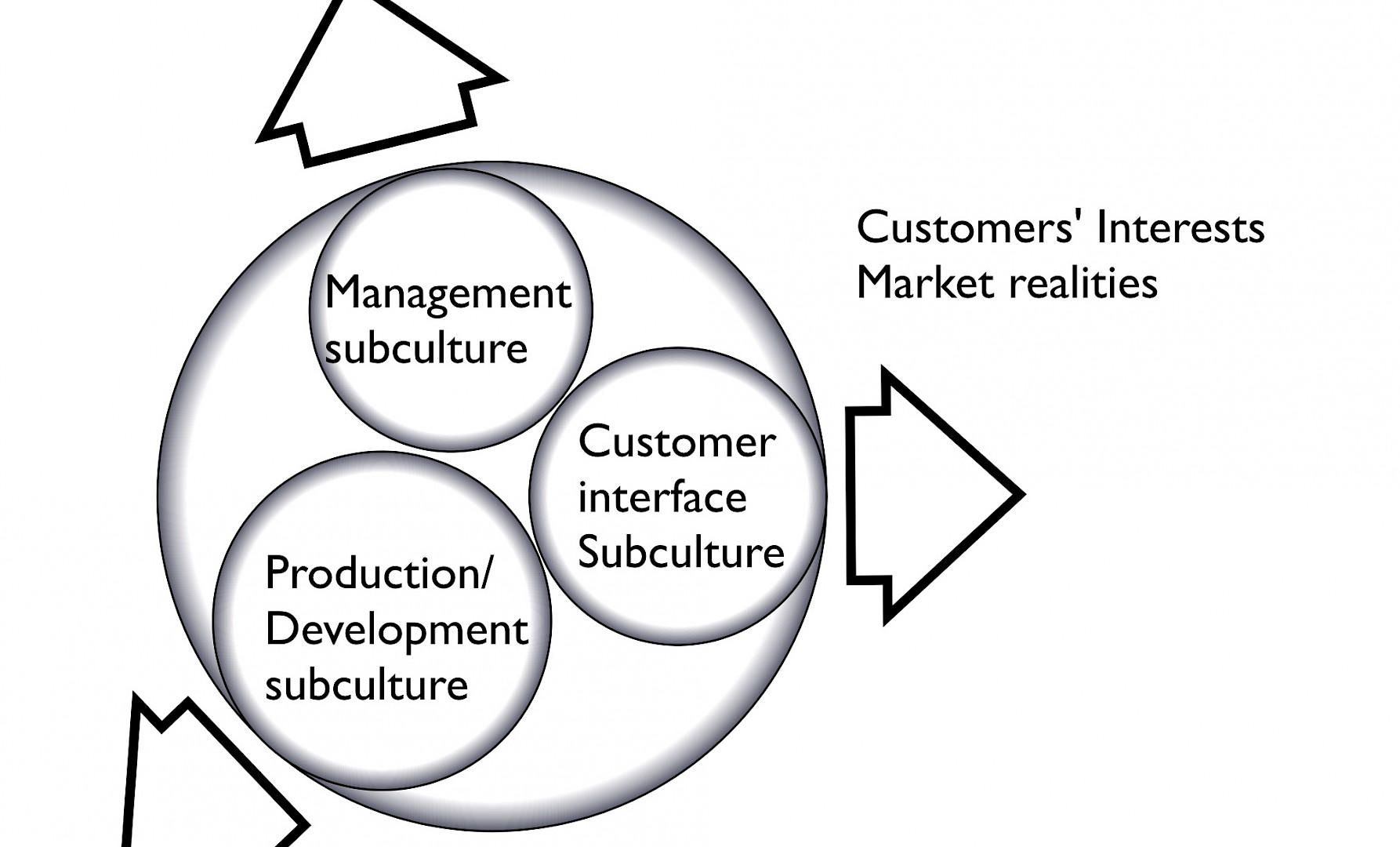
Earlier I commented on the Gap between the R&D and Product Management. This time I look at the whole business. From theoretical point of view these phenomena are just obvious, I found their significance by observing real organizations. This model has been helpful for understanding the product manager's world.
I have seen this in many organizations, also in small companies. It hints, that healthy and close human interaction in an organization is a significant competitive advantage. Secondly, change is free, actually profitable - just Go and See and there will be many opportunities.
Three conflicting Interests
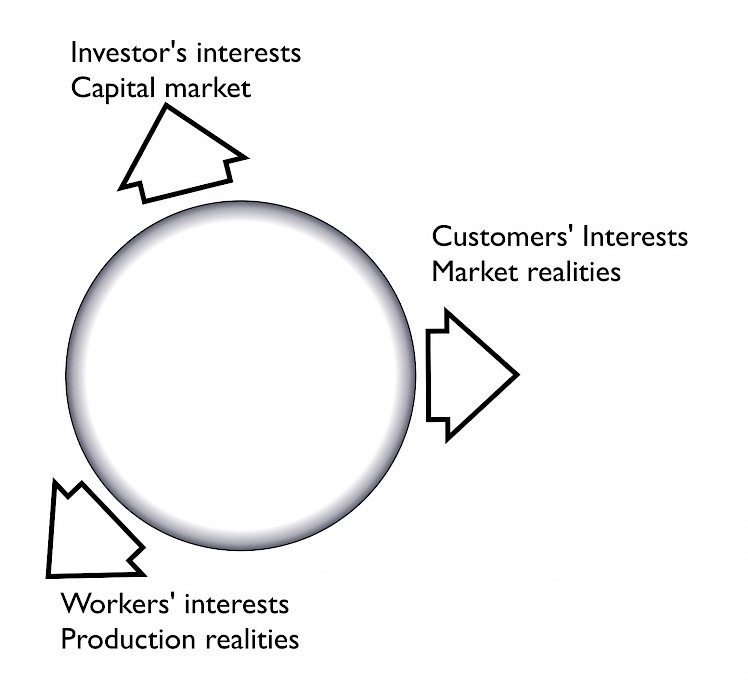
Every organization has three stakeholders that each have a significant Interests. There are high stakes, energy and passion. (interest with a capital I refers to the specific Interests)
- The investors are playing in the capital market. They wish for a reasonable ROI and fear for losing their investment.
- The customers and end users wish for a functional product for a reasonable price, and fear e.g. for bad quality and difficulties in the support.
- The value adding workers wish e.g. for satisfactory working condition, a reasonable compensation and a safe future.
All three stakeholders need the organization, wishing it to stay alive and productive. All stakeholders have both long and short term interests. The cohesive and conflicting Interests are present in big and small units, departments and teams. Even individuals balance between these Interests in everyday decision making. "For the next few minutes, should I rest, write code, make another automated test or learn a new trick?" The real reality accumulates from these moments.
An individual represents different roles at different contexts. A team leader represents the customer and investor for the team, and represents her team at her own peer group.
The stakeholders may have siblings, many customers, many workers and many investors, to make the playground more complicated.
Every organizational culture will find a balance between the Interests. The ways to solve the conflict may differ, it is called politics. Some organizations speak openly, some avoid conflict, some have taboos and so on. There will be political parties, even worker's unions. The balance may be dynamic, oscillating between attractors.
The leaders, especially the founder, shape the organizational culture. It may happen that:
- When the management is uncertain of it's own leadership, or uncertain of the integrity of the organization, even a thought of a ground-laying conflict may be too threatening to be discussed. Instead of negotiating the balance, all effort is concentrated to find a unifying vision.
- Besides the blunt denial, a more subtle defense is to look for a perfect process. Artifacts are just delivered, people do what is told, and everything is fine - no need to receive feedback and solve conflict.
- The leaders may personally tend to avoid conflict, or have the habit to solve conflicts in a nonproductive way.
Avoiding conflict regarding the Interests leads to cultural anomalies, suboptimal performance and suffering.
The Interests cause the emergence of the corresponding subcultures
The internal cohesion and difference between the subcultures follows from the daily practical work and challenges. The everyday mental states and bodily experiences gradually define what is important for each individual. You can recognize the different meanings from the "Yes, but ..." discussion. It means "Yes, I understood your rational argument, but from my perspective different things are important, did you hear me?"
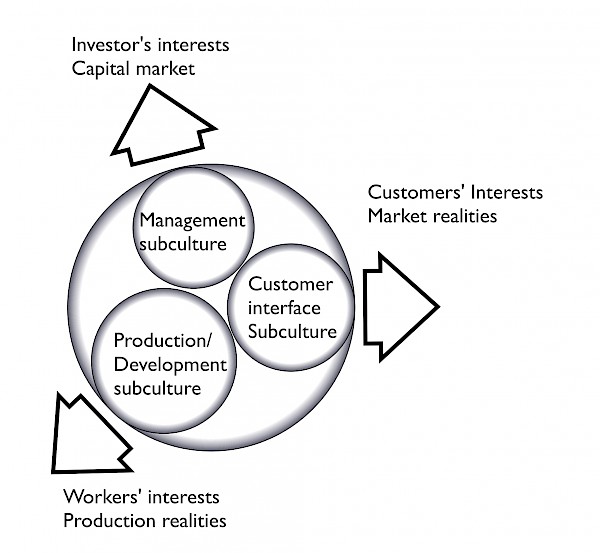
The representatives of the subcultures defend towards the tension in many ways, typically by reducing and diluting the unpleasant interaction by for example ritualization or value denial. Your own subculture group is considered better than the others (see Sadomasochistic organizational cultures)
For example the people at the customer interface feel personally the pain of the customer waiting for a release or struggling with pricing. It may happen, that the customer interface has more sympathy towards the customer than towards the own R&D. This follows from: a) with whom do I have most personal interaction b) who do I think has the most power over me.
By definition, the upper management is the guardian of the Investors' Interests.
The workers' context is the production realities, and they represent themselves. This creates a problematic unsymmetry to the negotiation. The customer interface says "The customer needs this, or they swap and we go bankrupt." A worker says "I need proper working conditions, I think investing to this training would increase my productivity."
The status/power differences limit the dialogue efficiently. Information is withheld, expression of feelings is either aggressive or nonexistent. Instead of continuous interaction, the dialogue drifts to sparse and abstract communication in big batches.
There are also different kinds of power. The upper management has the authorization to change the big boundary conditions, to order where money and time is used. On the other hand they have very little power over the zillion small floor level decisions, that sum up to reality.
A leadership vacuum at the critical center
Significant decisions balancing the three Interests happen in the center of the organization, between the subcultures. When the subcultures are strong, they have power that they don't want to give up. A vacuum is born between the three subcultures, in the middle of the organization, exactly in the place where the important decisions need to be made.
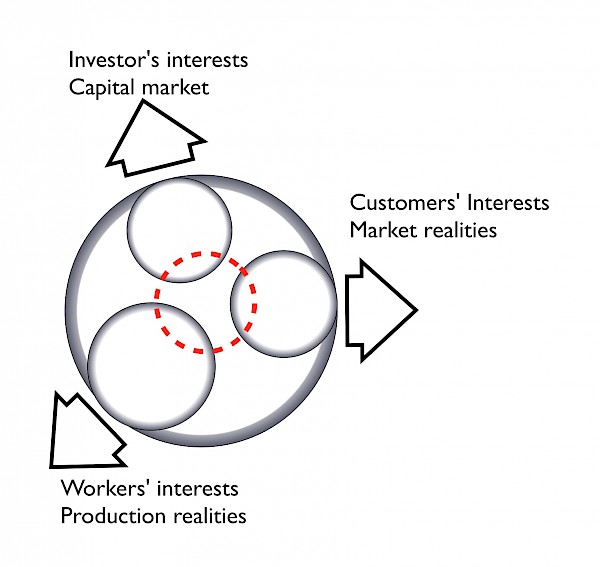
The job at the center is challenging:
- The three Interests
- The sibling envy and competition between several customers, between several investors and between several value adding workers/organizations.
- Balancing short and long term
- Legacy - the overt and covert assumptions, agreements, practices and technology inherited from history
- The stakes and pressure is high. Uncertainty, fear - defensive behavior. There may be messianic expectations towards a new manager, organization or consultant in the center.
- Maximal distance to the reality. In a bigger organization, the touch to any stakeholder is only indirect
- Complicated environment. Things need to be simplified and abstracted, so that they could be comprehended. When decisions are made, they do not realize at all, or something very different happens.
So the opportunity to make real decisions is limited. Many managers feel helpless.
Typical organizational roles at the center are product manager, project manager, middle management and the Product Owner. The concrete coordination and decisions that they do has potentially a great impact to what happens. But often the money and time is spent differently - the real decisions did emerge in some other way. Some other symptoms of the vacuum are:
- Nonfunctional or fake resourcing, prioritization or portfolio management
- The product management is actually a secretary, recording what did happen.
- The business risk and leadership responsibility is left to the development/production.
- The customer dictates, what the R&D makes.
- The customers get unrealistic promises.
- Parallel projects compete against each other. Some individual project succeeds, but the whole organization is not productive.
- In a (continuous?) crisis the upper management makes unrealistic product decisions and reorganizations, based on limited knowledge.
- Churn - the problems at the production are solved temporarily, in projects, but learning, standardization and other long term development does not happen in spite of the spent effort.
The dialogue between the subcultures is demanding in many ways. You need to consider unconscious phenomena, group dynamics, need for conflict mediation, leadership, the organizational structure, measuring. Constructive and thorough conflict resolution is very important - it makes the quality of the organization. I have seen the following attempts to solve the vacuum:
- Establish a new decision making organization, stronger than ever, for example a new product management. Supply it with even naive advice like "Sponsor only profitable products." (Seen it!) The danger is, that this is only a bigger dose of the culturally appropriate medicine, that did not work earlier. There will possibly be three separate subcultures inside the newly established organization.
- Steering groups will easily be forums of power struggle. In reality the decisions are prepared in the background. There might be several decision making forums, that dilute each others' decisions. Social and unconscious phenomena may dominate the steering group meetings.
- Outsourcing and the related wish for economical optimizing are very tempting. But how often a great real reason is that the internal conflict and competition can not be handled by the management. Why would it be cheaper to create the service when there is one more administrative player involved. The reality of outsourcing has often been rude.
- Projects will solve the problems one at a time. Please look at Focusing on projects ruins your business.
- Nominate the Product Owner and create the one prioritized backlog. Not enough alone.
The Gaps between the subcultures
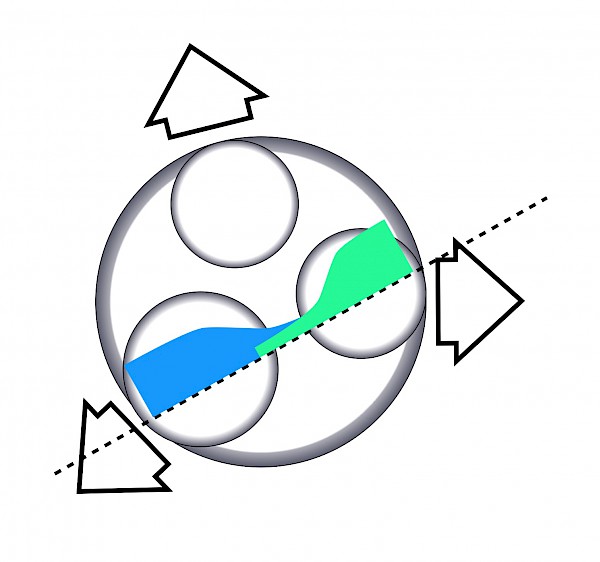
This figure is derived from observed gaps and subcultures. It has the same topology as the traditional process model from the production to the customer, supported by the management.
In my previous article, I described the gaps in the horizontal dimension.
The other dimension is between the investors and the floor level. In a similar way, there may be several and deep gaps in this dimension, depending on the size and culture of the organization. I won't open the Pandora's box of leadership here. In principle, similar medicines apply.
The medicine
This is my choice and wording. For more food for thought, please study the Lean literature.
Small batches fully done
This is The Way to reduce complexity, to enable measurability, control and agility to the organization. This is a Lean revolution, dramatic change owned, driven and personally needed by the top management.
Noneffective portfolio management can be cured by creating the portfolio-wide heartbeat, and gradually shortening the cycle. I don't expect this to be easy. In other words cadence is a way to reduce the coordination cost.
Around 1990, still in my previous profession of structural mechanics, I applied a job at Kone Cranes, a leading company designing and manufacturing big cranes. They did a full closing of accounts every month. This was the first thing told to an applicant of a technical job. They have been successful in the business.
For your convenience a quote from the previous blog. Continuous flow of small batches done. Since the emotional reasons are so strong in forming the Gap, I emphasize the emotional side of small batches:
- Small batches are less complicated, understandable and manageable to the limited human cognition. (the more people the more limited)
- The emotional load transferred and born at the interaction can be handled, is not too much.
- The flow of batches enables the flow of feedback and learning. Learning is proportional to the number of cycles, not size.
Avoid overspecialization
Please differentiate between competence and roles!
You need to have deep competence in the value creating essence. It does not exclude wide participance to diverse value creating activities. On the contrary, hearing specialists widely is beneficial. Knowledge is created in interaction.
However, the narrow organizational roles and responsibilities is an artificial choice, constraining the organizational conversation; limiting self-organization, empowerment and communication.

Quality of information sharing versus number of roles
The organizational roles here mean individuals and specialized organizations, like separate testing organization, separate architects, separate quality and process. Splitting leadership into roles instead of empowered units effectively adds knowledge waste. Matrix organization is risky.
A big organization easily develops an amazing amount of coordinators, who organize the work of overspecialized passive resources. This leads to complicated organization, eternal simultaneous idling and lack of resources, friction, loss of knowledge and finally an organizational deadlock.
Minimalistic aesthetics works here. Remove roles, until you can not take any away without breaking the whole.
Research by Jim Coplien shows that the number of different roles has inverse correlation to the healthy communication in software projects. More at Jeff Sutherland's blog and Jim's presentation.
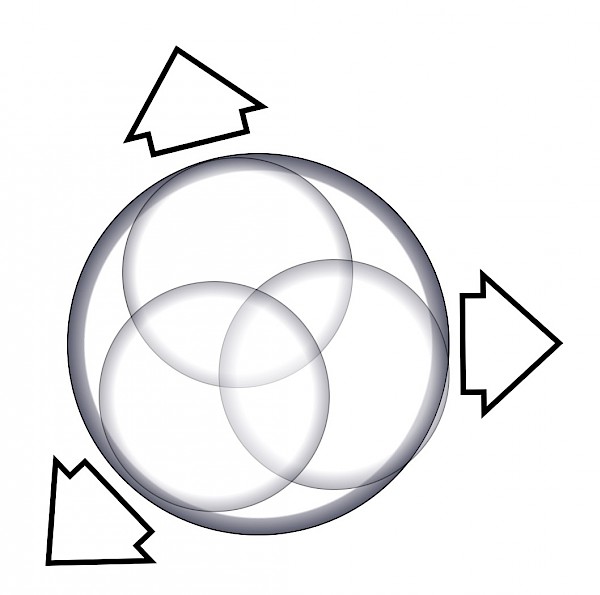
Some organizations have less separation between roles. My belief is that it follows from the ways to respond to conflict and diversity.
Fearless and constructive conflict resolution
The usual pointer to this theme might be continuous learning. I wanted to emphasize the necessary enabler.
This means hearing, expressing and accepting the diverse and subjective perspective - personal interests, needs and feelings. Please differentiate the freedom of speech from decision to act. Leadership, beware of unconscious compulsion to cure all problems.
Fortunately, communicating interest instead of actions empowers and makes people more understandable and approachable!
In the leadership and organizational culture this is related to learning, openness, continuous improvement, Gemba (go and see for the management), teamwork, emotional intelligence, high integrity and so on.
This is true respecting people, that stands even hard times.

